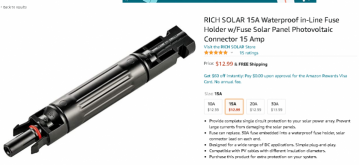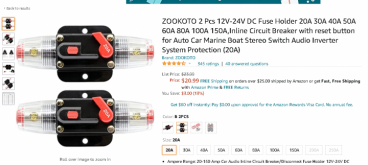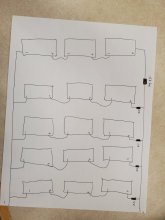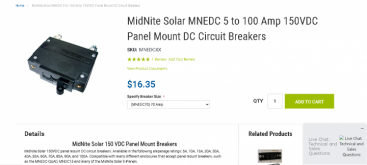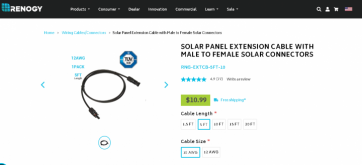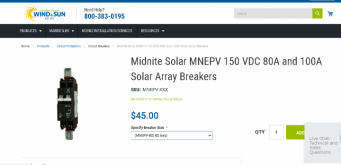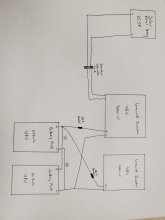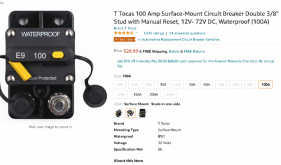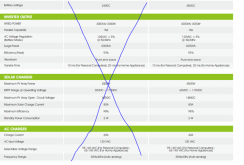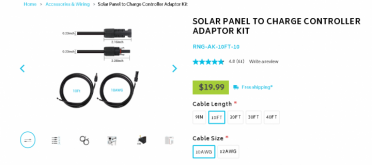dawgleader1
New Member
- Joined
- Mar 9, 2020
- Messages
- 19
Hey all, I'm a newbie to solar and I'm working on my first system. I've made a couple other posts and received great advice so far from some of the members here. Since my last post I've taken the advice and done a lot of additional research and revamped my plans with a better understanding of what I'm doing (I hope). I will still preface this by saying I'm a moron when it comes to this kind of thing and my eyes can go cross when trying to understand electrical and engineering. That being said I've come up with what I think is a workable and safe system.
Backstory: My goal with the system is to have an off grid, emergency back up electrical system. This would be for powering the essentials after a bad storm, a downed tree, or zombie apocalypse. We'd mainly be using it to keep the refrigerator and freezer going and, if we have an abundance of sun coming in, maybe run a microwave or toaster oven here and there. I live in South Carolina and I'm counting on 4ish sun hours a day, less in the winter and more in the summer months of course. I'm trying to make it where my panels are mobile so that we can take them down during 'normal times' and put them up when needed and even move them from spot to spot during the year to collect as much sun as we can. My idea is that the inverter/ battery powerwalls will always be plugged into a home AC outlet to keep the batteries fully charged so if we lose power, we have 20kwh already on hand and then we'd throw the panels up and drop the already prepared cable to collect sun until electricity from the grid is restored.
The system: I have 15x 250w solar panels, 2x 48v 10kwh all-in-one battery powerwalls, and 2x 48v 3000w Growatt all-in-one inverters. I have attached the spec sheets below for review. I will be connecting my panels in 3s5p connection for almost 3800 watts total, the battery powerwalls in parallel to give me 20kwh of power storage, and the inverters in parallel to give me a total of 6k watts from my inverters. The best places on my property with the best sun exposure for the panel set up will be between 100-150' from the inverters & battery powerwalls so I'm trying to utilize proper gauge wire to limit loss and guarantee safety. I'm planning on using 6 AWG wiring for my solar panel array since it's rated for up to 55a; I'll be using 4 awg for my inverter and battery powerwall connections. I am planning on inserting a breaker between the solar panel array and the parallel connected inverters as a safety precaution. In an attempt to make it easy and clear, I've attached a couple sketches below to show my plans. All comments, advice, suggestions, and warnings are greatly appreciated but I have a few specific questions:
1) Is the attached (picture below) breaker ok for this purpose? if not, what's wrong with it so I can look for a better option? Or do I even need a breaker since my Growatts have built-in protection? I felt redundancy in this case was a good idea since I don't want to burn my house down or damage my system.
2) Do I need to add any additional breaker or fuses between the battery powerwalls and inverter? many of the schematics I've looked at have them but with my powerwalls I believe they have all the necessary protection built-in, but I may be wrong. If I need to add a fuse or breaker here please advise on what I would need.
3) Am I good on the 6 awg wire for my panel array? From the calculators and charts I've looked at, if I'm understanding them correctly, I would be running 4-5.5% loss, which I think I'm ok with unless there is a safety issue I'm not aware of yet. From what I understand, going with 4 awg would result in a 2.5-3.5% loss, so not a HUGE difference in the grand scheme of things, at least I don't think. I've found some 6 awg wiring that I'm probably going with and have attached the picture below, is this good or should I look at something different. I wasn't able to find any reasonable price on 4 awg, at least not yet, but if that's what I need to go with I'll do some more digging.
4) with the wiring above, since I want to be able to move my panels from spot to spot on the property and this isn't a year round, out in the weather system, is is ok just to run the cable across the ground? Or do I need to run it through a PVC conduit pipe or even underground?
5) Do I need to incorporate a bare copper ground wire? I don't think I need it but I have seen some people talking about it so just wanted to check. If so where along the line would I connect that?
Well that about wraps it up. I've attached as much info that I can think would be relevant but if you need to know something else to make suggestions pleas just ask. Thank you very, very much! I greatly appreciate any and all help offered.
Backstory: My goal with the system is to have an off grid, emergency back up electrical system. This would be for powering the essentials after a bad storm, a downed tree, or zombie apocalypse. We'd mainly be using it to keep the refrigerator and freezer going and, if we have an abundance of sun coming in, maybe run a microwave or toaster oven here and there. I live in South Carolina and I'm counting on 4ish sun hours a day, less in the winter and more in the summer months of course. I'm trying to make it where my panels are mobile so that we can take them down during 'normal times' and put them up when needed and even move them from spot to spot during the year to collect as much sun as we can. My idea is that the inverter/ battery powerwalls will always be plugged into a home AC outlet to keep the batteries fully charged so if we lose power, we have 20kwh already on hand and then we'd throw the panels up and drop the already prepared cable to collect sun until electricity from the grid is restored.
The system: I have 15x 250w solar panels, 2x 48v 10kwh all-in-one battery powerwalls, and 2x 48v 3000w Growatt all-in-one inverters. I have attached the spec sheets below for review. I will be connecting my panels in 3s5p connection for almost 3800 watts total, the battery powerwalls in parallel to give me 20kwh of power storage, and the inverters in parallel to give me a total of 6k watts from my inverters. The best places on my property with the best sun exposure for the panel set up will be between 100-150' from the inverters & battery powerwalls so I'm trying to utilize proper gauge wire to limit loss and guarantee safety. I'm planning on using 6 AWG wiring for my solar panel array since it's rated for up to 55a; I'll be using 4 awg for my inverter and battery powerwall connections. I am planning on inserting a breaker between the solar panel array and the parallel connected inverters as a safety precaution. In an attempt to make it easy and clear, I've attached a couple sketches below to show my plans. All comments, advice, suggestions, and warnings are greatly appreciated but I have a few specific questions:
1) Is the attached (picture below) breaker ok for this purpose? if not, what's wrong with it so I can look for a better option? Or do I even need a breaker since my Growatts have built-in protection? I felt redundancy in this case was a good idea since I don't want to burn my house down or damage my system.
2) Do I need to add any additional breaker or fuses between the battery powerwalls and inverter? many of the schematics I've looked at have them but with my powerwalls I believe they have all the necessary protection built-in, but I may be wrong. If I need to add a fuse or breaker here please advise on what I would need.
3) Am I good on the 6 awg wire for my panel array? From the calculators and charts I've looked at, if I'm understanding them correctly, I would be running 4-5.5% loss, which I think I'm ok with unless there is a safety issue I'm not aware of yet. From what I understand, going with 4 awg would result in a 2.5-3.5% loss, so not a HUGE difference in the grand scheme of things, at least I don't think. I've found some 6 awg wiring that I'm probably going with and have attached the picture below, is this good or should I look at something different. I wasn't able to find any reasonable price on 4 awg, at least not yet, but if that's what I need to go with I'll do some more digging.
4) with the wiring above, since I want to be able to move my panels from spot to spot on the property and this isn't a year round, out in the weather system, is is ok just to run the cable across the ground? Or do I need to run it through a PVC conduit pipe or even underground?
5) Do I need to incorporate a bare copper ground wire? I don't think I need it but I have seen some people talking about it so just wanted to check. If so where along the line would I connect that?
Well that about wraps it up. I've attached as much info that I can think would be relevant but if you need to know something else to make suggestions pleas just ask. Thank you very, very much! I greatly appreciate any and all help offered.
Attachments
-
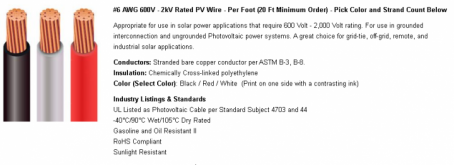 6 awg wire.PNG126.9 KB · Views: 27
6 awg wire.PNG126.9 KB · Views: 27 -
 Circuit breaker option 1.PNG179.7 KB · Views: 15
Circuit breaker option 1.PNG179.7 KB · Views: 15 -
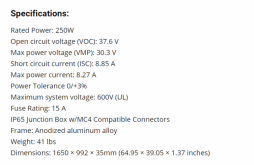 solar panel spec pic.PNG152.6 KB · Views: 17
solar panel spec pic.PNG152.6 KB · Views: 17 -
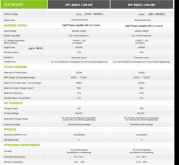 Growatt inverter specs.PNG220.5 KB · Views: 14
Growatt inverter specs.PNG220.5 KB · Views: 14 -
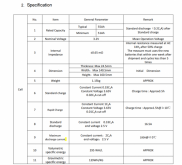 battery specs.PNG246.9 KB · Views: 15
battery specs.PNG246.9 KB · Views: 15 -
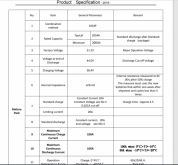 battery specs2.PNG231 KB · Views: 18
battery specs2.PNG231 KB · Views: 18 -
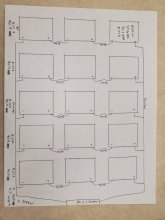 solar panel array sketch.jpg84.7 KB · Views: 27
solar panel array sketch.jpg84.7 KB · Views: 27 -
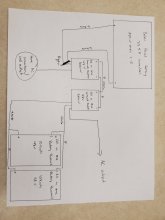 whole system sketch.jpg71.8 KB · Views: 30
whole system sketch.jpg71.8 KB · Views: 30




